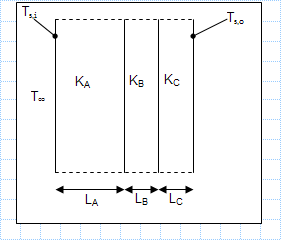Heat loss through a composite wall of three materials.xls

Description
KNOWN: Thicknesses of three materials which form a composite wall and thermal conductivities of the two materials. Inner and outer surface temperatures of the composite: also, temperature and convection coefficient associated with adjoining gas.
FIND: Value of unknown thermal conductivity, kB.
ASSUMPTIONS: 1) Steady-state conditions
2) One-dimensional conduction
3) Constant properties
4) Negligible contact resistance
5) Negligible radiation effects
ANALYSIS: Analogy with thermal circuit.
Calculation Reference
Fundamentals of Heat and Mass Transfer - Frank P. Incropera
To find the unknown thermal conductivity (kB) in a composite wall, we can use the analogy of a thermal circuit, which represents the flow of heat through the different layers of the composite wall. Here's how you can approach the analysis:
-
Identify the layers and their properties: Identify the three materials that form the composite wall and note their respective thicknesses (L1, L2, L3) and thermal conductivities (k1, k2, k3). Let's assume material 1 is the innermost layer, material 2 is the middle layer with the unknown thermal conductivity (kB), and material 3 is the outermost layer.
-
Establish thermal resistances: Assign thermal resistances to each layer of the composite wall. The thermal resistance (R) of each layer is calculated as the thickness divided by the thermal conductivity: R = L / k.
-
Apply thermal circuit analogy: Treat the composite wall as a series of resistances connected in series. The total thermal resistance (R_total) is the sum of the individual thermal resistances:
R_total = R1 + R2 + R3
Substitute the thermal resistances with their respective values using the thicknesses and thermal conductivities of the materials.
-
Apply the temperature boundary conditions: Determine the temperature difference (ΔT) between the inner and outer surfaces of the composite wall. ΔT = T_outer - T_inner.
-
Calculate the heat transfer rate: Use the formula for heat transfer rate (Q) through a composite wall:
Q = (T_outer - T_inner) / R_total
Substitute the values of ΔT and R_total from the previous steps.
-
Consider the adjoining gas convection: If there is convective heat transfer between the outer surface of the composite wall and the adjoining gas, you'll need to account for it by incorporating the convection coefficient (h) into the heat transfer equation. The modified equation will be:
Q = h * A * (T_outer - T_gas)
Where A is the surface area of the composite wall and T_gas is the temperature of the adjoining gas.
-
Solve for the unknown thermal conductivity: Rearrange the equation to solve for kB:
kB = Q / (h * A) + k1 / R1 + k3 / R3 - k2 / R2
Substitute the known values of Q, h, A, k1, k3, R1, R3, and solve for kB.
By treating the composite wall as a thermal circuit and using the above steps, you can determine the value of the unknown thermal conductivity (kB) of the middle layer.
Calculation Preview
Full download access to any calculation is available to users with a paid or awarded subscription (XLC Pro).
Subscriptions are free to contributors to the site, alternatively they can be purchased.
Click here for information on subscriptions.

